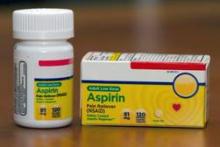More than 1 in 10 heart patients are inappropriately prescribed aspirin therapy for the prevention of cardiovascular disease, and there’s wide variation by practice in that proportion, according to a registry analysis published Jan. 12 in the Journal of the American College of Cardiology.
In a study of patients in the National Cardiovascular Data Registry’s Practice Innovation and Clinical Excellence (PINNACLE) registry, 11.6% of heart patients were prescribed aspirin even though they did not meet American Heart Association guidelines for the use of aspirin in cardiovascular disease (CVD) prevention.
Dr. Ravi S. Hira and colleagues of the Baylor College of Medicine in Houston collected data from 68,808 patients in the PINNACLE registry who received aspirin between January 2008 and June 2013. Participants were excluded if they were taking aspirin for secondary prevention (such as a history of MI, stroke, or other cardiovascular events) or if they were also taking warfarin, clopidogrel, ticlopidine, or an aspirin/dipyridamole combination (JACC 2015 [doi:10.1016/j.jacc.2014.10.035]).
The investigators defined “inappropriate aspirin use” as aspirin therapy in patients with a 10-year risk of a cardiovascular event of less than 6%. The AHA recommends aspirin use only in patients with a 10-year CVD risk of at least 6%, mainly because the risk of gastrointestinal bleeding and hemorrhagic stroke outweighs any potential benefit in low-risk CVD patients, the authors reported.
A total of 7,972 patients had a 10-year CVD risk of less than 6% and therefore were prescribed aspirin inappropriately. About 80% of them were women, and the frequency of inappropriate aspirin use was 16.6% in women and 5.3% in men. The authors explained that guidelines recommend aspirin use for postmenopausal women because participants of the Women’s Health Initiative who took aspirin had reduced major cardiovascular events, and those over age 65 in particular had reduced ischemic stroke. They performed a sensitivity analysis to adjust for this, and found similar results.
However, during the 5-year study period, inappropriate use declined from 14.5% to 9.1%.
Patients who received aspirin inappropriately were younger, with a mean age of 58 years, versus a mean age of 66 years in patients who received aspirin appropriately. Those who received appropriate aspirin therapy were mostly male; had diabetes, hypertension, or dyslipidemia; and were smokers.
There was wide variation in inappropriate aspirin therapy depending on practice characteristics. Overall, the likelihood that two randomly chosen practices would differ in treatment of “identical” patients was 1.63. Specifically, larger practices (with median 13 physicians vs. 8), and those that participated in PINNACLE longer (24 months vs. 16 months), were significantly more likely to promote inappropriate aspirin use.
“Our results provide an important benchmark for inappropriate aspirin use for primary CVD prevention in contemporary outpatient U.S. practices,” Dr. Hira and his associates wrote. Although the benefits of aspirin may outweigh bleeding risk in high-risk patients because of the presence of several cardiovascular risk factors, “patients who are at low risk for cardiovascular events could be harmed by aspirin use due to an increased risk of major bleeding,” they said.
The results of this study underscore the need to improve evidence-based aspirin use for cardiovascular disease prevention, the authors added.
The investigators disclosed financial relationships with Anthera, GE, Tomtec, AstraZeneca, and numerous other companies.


